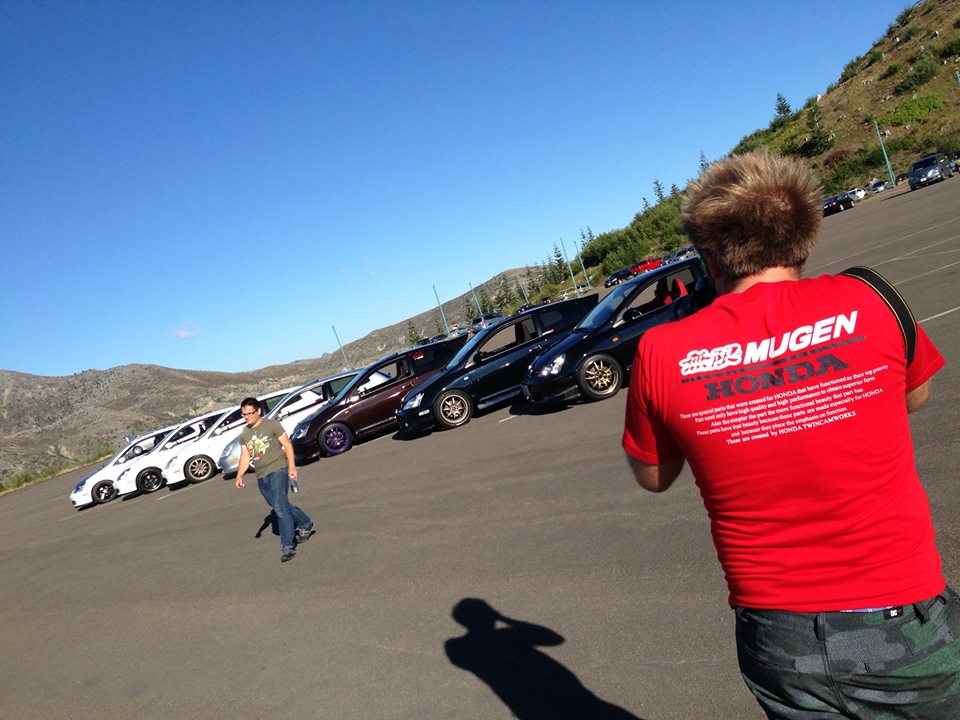
This past Labor Day we gathered a few EP3 Civics together for a Pacific Northwest mini-meet.
Seven EP3 owners from the Portland and Tacoma/Seattle areas met in Castle Rock, WA for grub. Bellies full of pizza, we headed up WA-504 for the 52 mile trip to the Johnston Ridge Observatory overlooking Mt. St. Helens.
Those of us with gray hair will remember Mt. St. Helens as the active stratovolcano that blew its top in May of 1980. The eruption scorched 230 square miles of forest and was the deadliest and most economically destructive volcanic event in all of US history. 30 years later, Mt. St. Helens looks downright other-worldly; it's clear something massive, dangerous and powerful happened here. The landscape just looks wrong -- yet it makes a natural sense all its own. It is rare to see so much landscape changed in such a short time.
If I was a better writer I would make some kind of deeply insightful comparison linking the shifting modifications of this landscape to the changes we've seen to our own EP3s over the years. Or to the reputation of the EP3s, or of Honda... but I'll spare you!
The Tacoma/Seattle guys roll up to our meeting point in Castle Rock. Julio leads the way, followed by Rick. John in the silver EP had intentionally popped the hood latch to give his motor a bit more cool air.

This is the 52-mile route we took from Castle Rock to the Johnston Ridge Observatory overlooking Mt. St. Helens.

We made up a nice caravan of seven as we headed up the hill. Here is a great shot Dave somehow took out of his sunroof, while driving. He managed to get all seven of us in one shot!
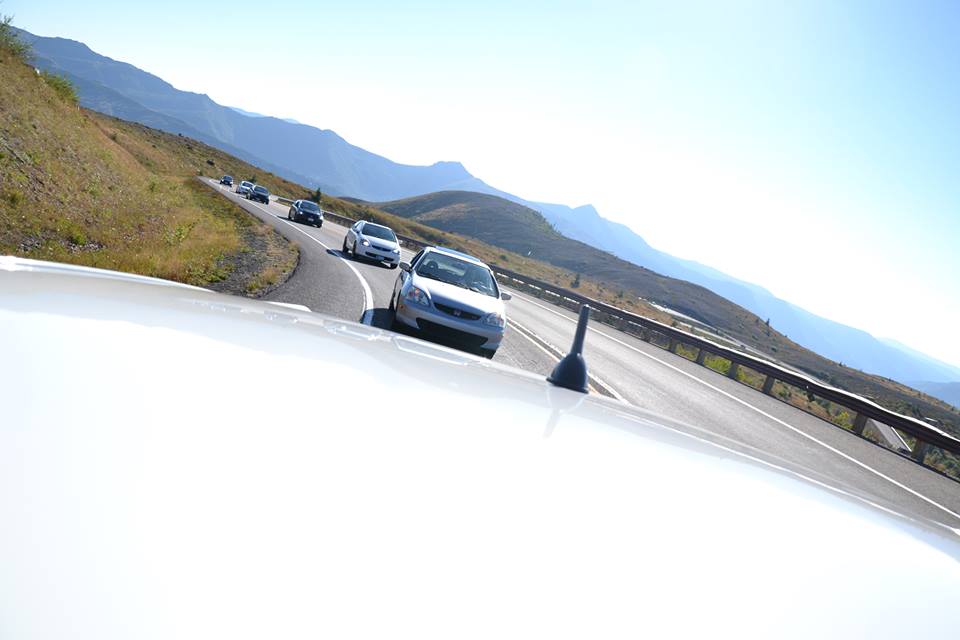
Dave led up the pack in his Taffeta White Si, setting a good pace on his Buddy Club N+ coilovers and black-coated RSX rims. His HKS exhaust roars ahead on the road that will take us up the mountain past shaded valleys, expansive bridges and wide-open, forested vistas.
Behind him was John -- an OG EP owner in a Satin Silver Metallic sleeper he's owned since it had 25 miles on the odometer. He hasn't stopped driving it since. On the way to today's meet he clicks over to 214,000 miles. John has the rare privilege to pick between an EP3 and an Apex Blue Pearl S2000 Club Racer (CR) in his garage -- and tells us that of all the dozen or so Hondas he's owned, he will never be able to part ways with his EP3. He just loves it too much.
Next was Todd, a Portlander who has quietly modded his white EP for years and has only recently been meeting up with other EP owners. He's a lurker on the forums that we finally got to come out and play. I met him when I purchased his Mr. Alex front strut bar from him in a Target parking lot last year. He's holding his own as we dive into the corners.
Behind him was Julio, driving our most modified EP of the day. Julio's ride has a custom metallic purple (root beer) paint job with genuine Mugen lip & grille on a JDM front end -- and a swapped motor. Actually I'm not sure how many motors he's had in this car. Maybe Julio has lost count too. His car has seen generous iterations of motors, suspensions, aero ... and survived an ordeal involving a turbo setup gone wrong. It's awesome to see that he stuck it out and has kept on modding.
Behind him is Brian, driving a Nighthawk Black Pearl EP on bronze 16" Konig rims with a Greddy exhaust. Springs drop it to an aggressive height. The car itself actually belongs to Dave's twin brother Andy (Yep, twin brothers with modded EP3s. That's how we do it in the PNW). The car is on loan for the day to Brian, who normally drives an S2000. Today he's driving Andy's EP so the car can join us for the drive, even if its owner couldn't.
Nearing the end of the caravan is Rick, with a white EP on bronze wheels with Mugen Sport Suspension. He's sporting a Volvo lip that looks amazing on his front bumper, giving it a nice chin that means business. A small German flag swings from his rear view mirror, a signal of his Bavarian lineage.
Bringing up the rear is me, in my black EP. I'm lamenting having left my Buddy Club suspension set on the softer side, but enjoying this chance to stretch my hatch's legs in a pack like this. It's a fun challenge to be the caboose in a seven-car line. I didn't realize just how much more information I would have to process, since I had a clear view of most of the caravan; Just as the leaders might be speeding up, others might be slowing down in a turn. Some might be tapping brakes to adjust following speed. My solution was to just hang back, to not follow too closely. It was like being the tail on an undulating Slinky, stretching and compressing in waves. I'd say I had one of the best views of the group -- not only did I get to enjoy the amazing scenery but also got to see all these clean EPs winding up these beautiful roads.
In a total coincidence, we actually passed a bone-stock, black EP3 headed the other direction. The driver didn't seem to know he had just passed seven of his biggest fans. Clearly not a fellow enthusiast!
Here we are at a scenic lookout point mid-way up the mountain. Mt. St. Helens is in the background.
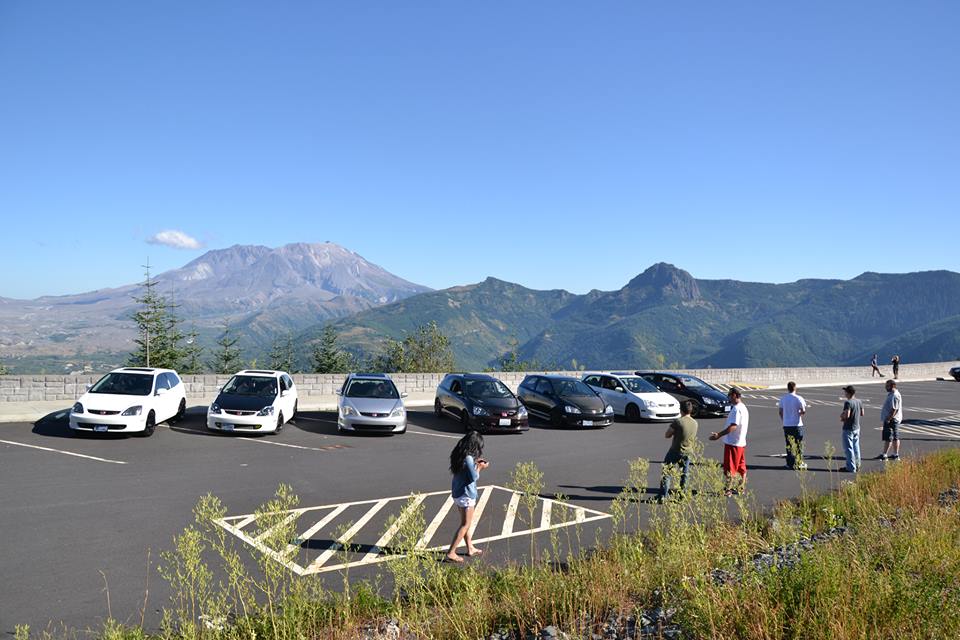
Sportin' the license plate frame of champions!
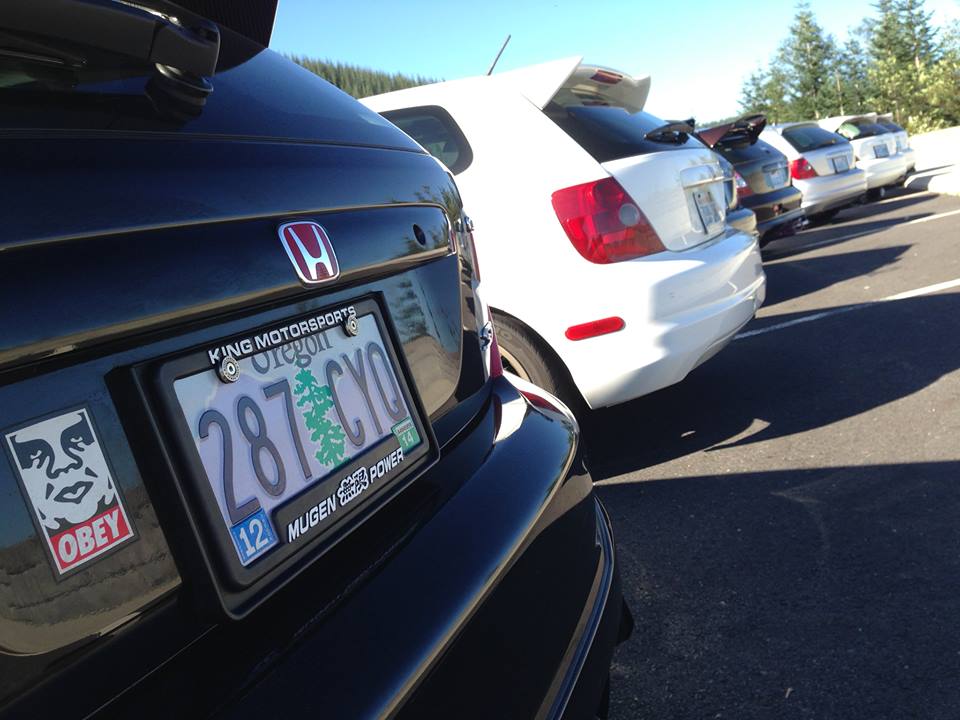
John's EP3, rocking the OEM 15" stockies and experimental plasti-dipped lower chin:

Reaching the observatory, we are treated to this alien landscape transformed by the dome-less Mt. St. Helens. Dave says the mountain lost 1000 feet of height in the eruption. The earth is already starting to push up a new mound in the crater that will one day be a new peak.

As the sun begins to set, we line our cars up for a final photo opp.
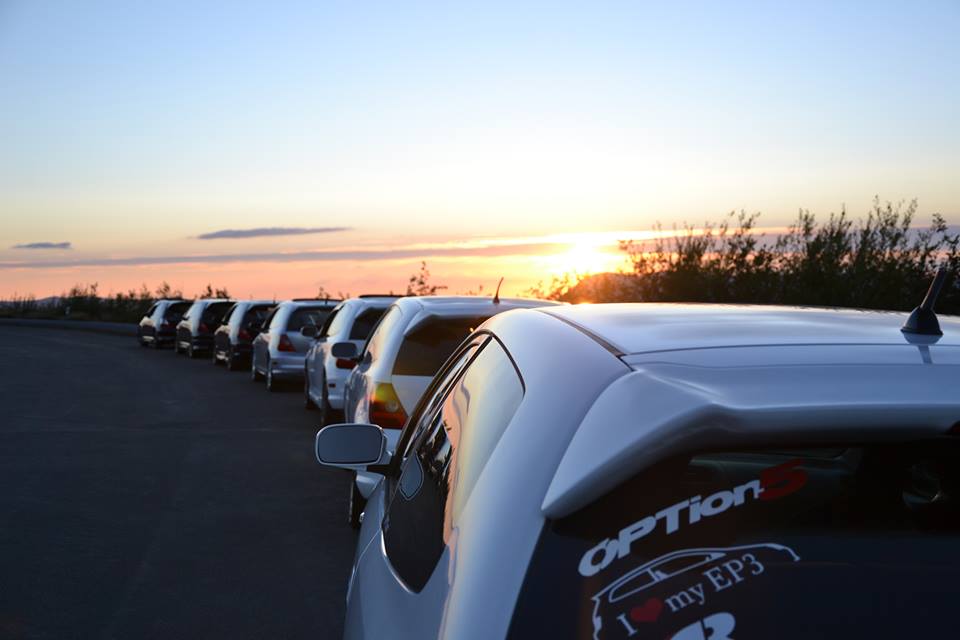
Below from left to right: Julio, Perry, Andy.
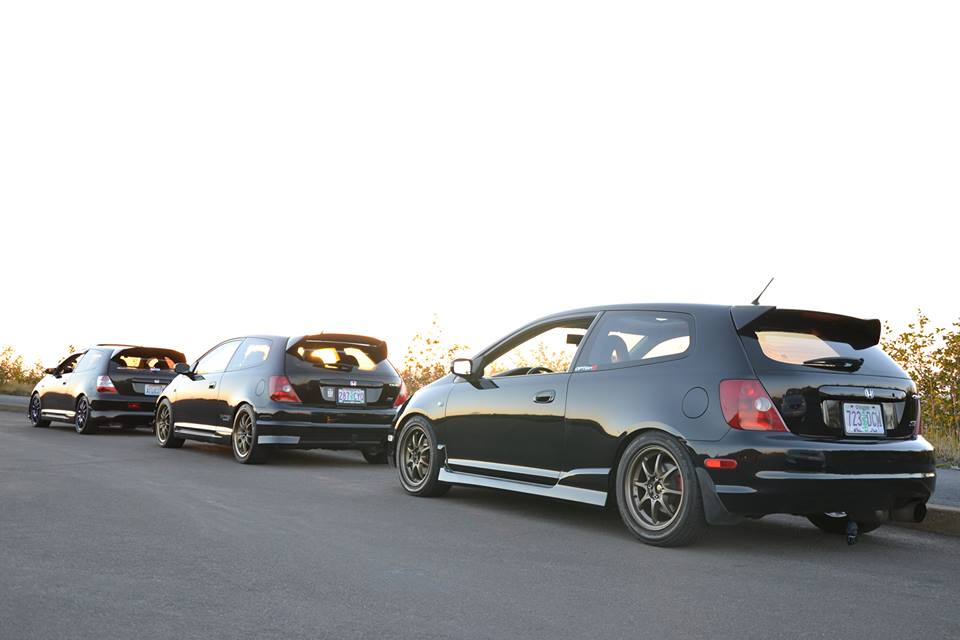
Below from left to right: Rick, Todd, Dave.
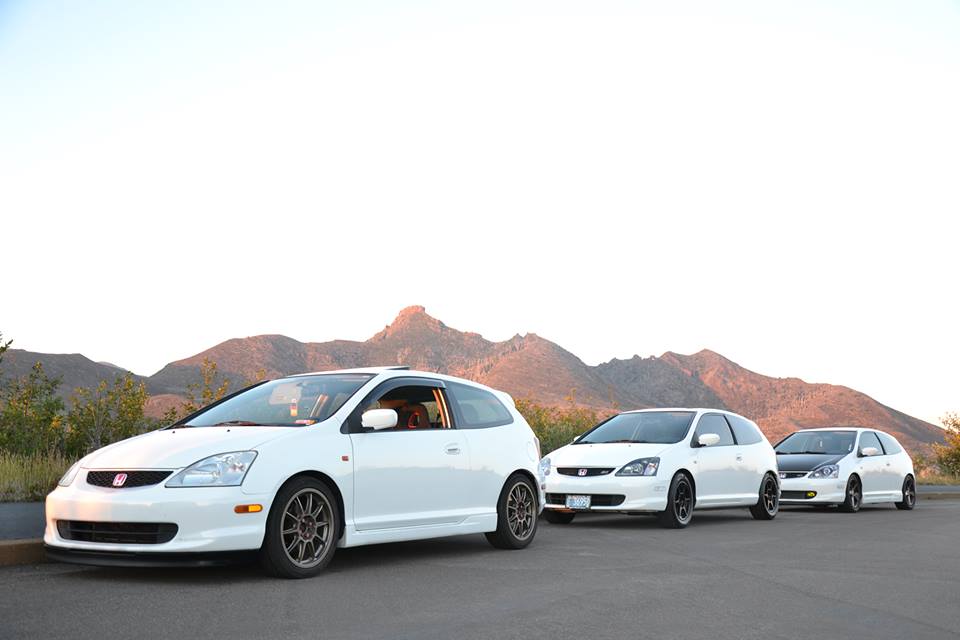
The parking lot for the observatory is massive. Our cars are lined up at the far end of the lot.

A closer look... can you spot the Prius in this lineup? Just kidding!
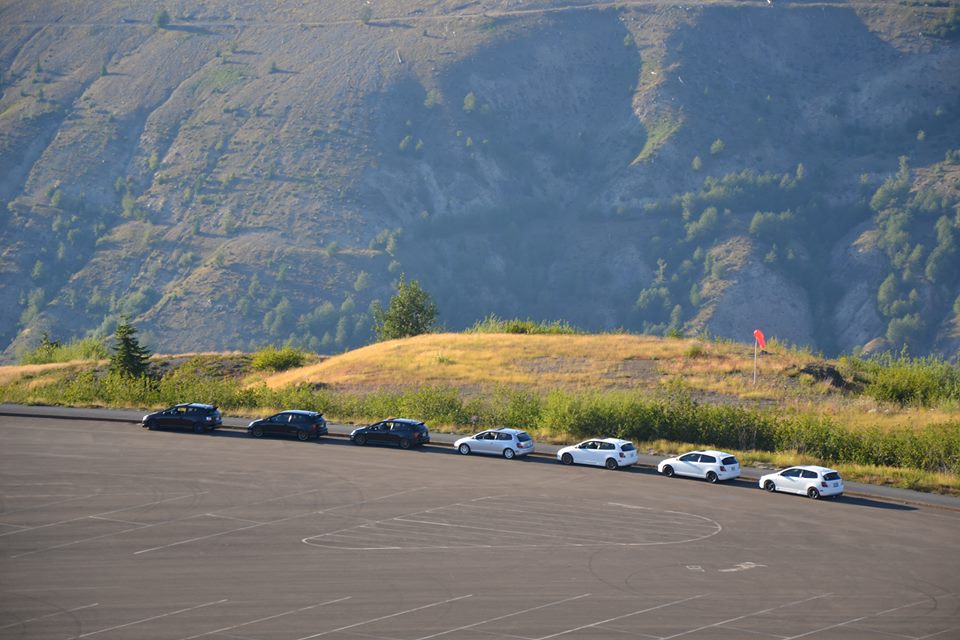
We decide to let the sun go down so it wouldn't blind us on the drive back.

The 2002-2005 Honda Civic Si hatchback never quite lived up to its overseas, beloved Type-R brothers. Out of the box it looked a bit like an egg, or perhaps a squat version of the Odyssey minivan. Pre-facelift, the car had tiny 15" rims. Despite these quirks, the EP3 provides ample opportunity for customization and dramatic improvements. The Recaro-made OEM seats, rally-style dash-mounted shifter and torque-blessed K-series are still a killer package that is hard to leave behind once you've driven an EP3. This last Stateside Si hatchback has just turned eleven years old and is being discovered and enjoyed by a new generation of Honda enthusiasts.
I'm looking forward to what the next decade of changes will bring for our EPs!
Photo credits: Dave O. and Perry W.
** Build Lists **
Dave's EP3
2004 Taffeta White
185,300 miles, owned since 2009
BuddyClub N+ suspension
HKS Hi-Power exhaust
DC Sports shorty header
BuddyClub Short Shifter
Tanabe strut bar
Neuspeed lower x-brace
HFP wing
Seibon CF hood
RSX wheels coated black - Dunlop Z1 Star Spec
Todd's EP3
2002 Taffeta White
87,000 miles, owned since 2003
AEM V2 intake
DC Sports shorty header
JP Performance mid-pipe
Neuspeed short shifter
Metal shifter bushings
15” Kosei K1s powder coated black
Bridgestone Potenzas RE960 205/60/15
Eibach Pro-kit
JDM rear sway bar with Energy Suspension bushings
HFP wing
DIY black headlight housings
Red/Black carbon fiber dash kit
Julio's EP3 (this is just a partial list!)
2004 Honda Rootbeer Metallic
84,200 miles, owned since 2006
K24A4
Hasport I/M Adapter Plate
Hondata I/M Gasket
RSX-S Injectors
K-Pro
DC Sport Shorty
HKS Hi-Power exhaust
C/F Spark Plug Cover and I/M Cover
Corsport Aluminum Shifter Cable Bushings
Corsports Aluminum Shifter Base Bushings
J's Racing Engine Torque Dampener
Buddy Club Short Shifter
JDM 04-05 Projectors w/ 8K HID kit
JDM 04-05 Taillights
JDM Front Bumper
Authentic 04-05 Mugen Lip
Authentic 04-05 Mugen Grille
ARC EK9 Splitters
JDM Rear Bumper and Lip
Benen Rear Tow Hook
Burnt Titanium Mugen Emblems
C/F Mugen Replica Hood
C/F Hatch
C/F Mugen Replica Wing
C/F Spoon Replica Mirrors
OEM Hood Bra
JDM Rear Rebar Mod
EDM DC2 Rear Foglight
Work Emotions CR-KAI (17x7)
Toyo Proxes 4 (205-40-17)
H&R 2" Lowering Springs
KYB Shocks
Corsport C-Pillar Bar
Corsport Rear Strut Bar
Corsport Adjustable Sway Bar Links
Omni Rear LCA's
Hardrace RCA's
Beaks Lower Tie Bar
DC-5 Rear Sway Bar
EM2 Front Sway Bar
Andy's EP3
2003 Nighthawk Black Pearl
92,500 miles, owned since 2006
Tokiko Blues with Neuspeed springs
Greddy EVO 2 exhaust
Injen short ram air intake
DC Sports Titanium strut bar
Neuspeed lower x-brace
HFP wing
HFP Side skirts
Fiber Images CF hood
Konig Helium wheels - Dunlop DZ101
Rick's EP3
2002 Taffeta White
130,000 miles, owned since 2008
17" Rota Tarmac II
Mugen Showa Sports Suspension
04-05 OEM side skirts
OEM JDM Type-R window visors
OEM hood bra (recently stolen but being replaced)
Custom catback exhaust
Short ram intake
OEM JDM RSX side markers (wired into parking lights)
HFP wing
Volvo front valance retrofit front lip
Perry's EP3
2002 Nighthawk Black Pearl
52,000 miles, original owner
BuddyClub N+ suspension
5-lug conversion (from 2003 RSX Type-S)
Mugen MF-10 17x7.5
AEM V2 intake
Greddy EVO 2 exhaust
Seats from JDM Integra Type-R DC5
EDM Type-R headlights with Morimoto projectors
Mugen grill
Replica carbon fiber Mugen wing
Carbon fiber front lip spoiler (Type-R style)
HFP rear lip
** Visit the King Motorsports store for parts for the EP3, including genuine Mugen bits **